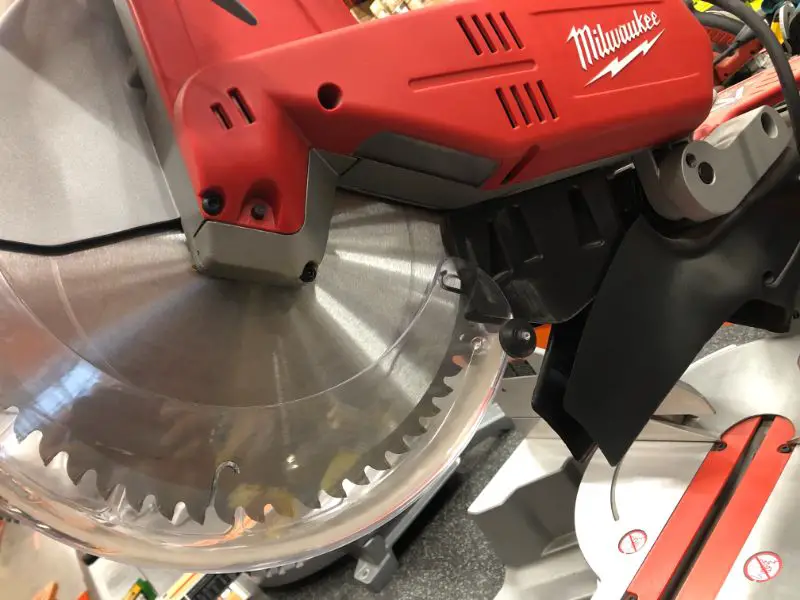If you are a novice in the carpentry and woodwork industry, you might be wondering if a wet saw is an upgraded mitre saw. The two power tools are used for different purposes, and the wet saw is not an upgraded version of a miter saw.
A wet saw is used to cut glass tiles while a miter saw is used for precise and accurate bevel cuts on pieces of wood and sometimes for cutting of PVC plastic pipes used for plumbing.
The two tools serve different functionalities and cannot be used interchangeably. A wet saw is used in the masonry industry while a mitre saw is mostly used in the woodwork and carpentry industry.
A wet saw uses an encrusted diamond blade to make cuts on tiles and to prevent them from breaking while cutting. During the cutting, a wet saw uses a jet to spray water on the blade to lubricate and cool the blade.
On the other hand, a miter saw uses rotating blades to make cuts on pieces of wood.
Every power tool should be used for its correct purpose to yield high productivity and to avoid cases of accidents. Attempting to use a mitre saw to cut tiles can be problematic and practically impossible.
You may damage your tool and expose yourself to danger as you could injure yourself in the process.
This piece will enlighten you on the differences between the wet saw and miter saw.
Difference between a Miter Saws and a Wet Saws
Is a wet saw an upgraded miter saw?” Well, as already said the two power tools are different and serve different functionalities.
A wet saw is ideal for accurate cutting of tiles without causing cracks on the surface while a miter saw is perfect for bevel cross cuts of wood surfaces.
A miter saw uses blades with teeth to make cuts on wood surfaces.
However, the blade of a wet saw does not have teeth which make them ideal for delicate materials. A wet saw is ideal on glasses and tiles as it can cut without causing damage to the surface being cut.
A wet saw can be used on a wide range of tile ceramics consisting of sand, water, and clay mixed to form a bake of a kilt and denser tiles made of clay such as the porcelain.
On the other hand, a miter saw is only ideal for dry wood surfaces and cannot be used on greenwood surfaces due to safety reasons.
Similarities between a Wet Saw and a Miter Saw
There are actually purpose built wet saws that have all the capabilities of a miter saw. These saws are for very specific uses by niche professional:
Although these two powerful tools are different and do not perform the same tasks, they have several similarities. Even then, it is important to note that a wet saw is not an upgraded mitre saw.
The following are some of the similarities between a miter saw and a wet saw.
Both miter saw and a wet saw are used to make accurate and precise cuts. The two power tools have been specially designed to make straight cuts without errors and mistakes.
A clean job is what you get by using these tools; they are tailored to maximize productivity when accurately used. The sharp rotating blades will help you save on time and energy.
Both miter saw and wet saw have motors that use power for them to operate. Although there are conventional saws that are manual, modern miter and wet saws, use power for them to run and make cuts.
Due to advancements in technology, we have some miter saws and wet saws equipped with laser guides and LED lights for accurate and precise cuts.
The beams produced by the two power tools’ laser guide are used by masonry and woodwork experts to make accurate cuts with zero mistakes and errors.
Both power tools are best used with a stand. Some stands are specially produced for wet and miter saws.
To increase efficiency and productivity, it is recommended that you use a stand while cutting various material surfaces.
Using a stand is also ideal for health and safety concerns as it will help you maintain an upright posture while cutting.
Mitre saws and wet saws use a rotating blade that swings downwards to make cuts. The two power tools are designed in such a way that the material surface being cut lays beneath the blades.
For proper functionality of these two tools, you should firmly fix the surface being cut to prevent it from falling and causing accidents.
Both wet saws and miter saws are robust and can be used to conduct tough cutting duties.
A miter saw can cut various types of woods with much ease even those that are thick. On the other hand, wet saws are ideal for domestic and commercial use as they can cut all types of glass tiles.
Although mitre saws and wet saws are used in different industries such as carpentry and masonry, renowned experts recommend both tools due to their high productivity, quality, and durability.
Both tools require safety precautions and guidelines when using them. A power tool should be used for its correct purpose to avoid any inconvenience. Inappropriate use of a wet and mitre saw could be hazardous as it could lead to injuries to the user.
Both miter saw and wet saw are for people who go for quality over cost. Both tools are slightly expensive as compared to other types of saws in the market.
Due to the advanced technology used in their production, they tend to be superior in quality, durability and robust functionality.
For novice users, mitre saws and wet saws come with a user manual that guides on the tools’ proper usability.
The user manual helps to get the much-needed insight in terms of functionality, maintenance and repair of the tool.
That said, a wet saw is not an upgraded miter as many may assume. A miter saw is used in the woodwork industry to make accurate and precise bevel crosscut while on a wet saw is used in the masonry industry to cut glass tiles.
To yield maximum productivity, use the right tool for the right job.


